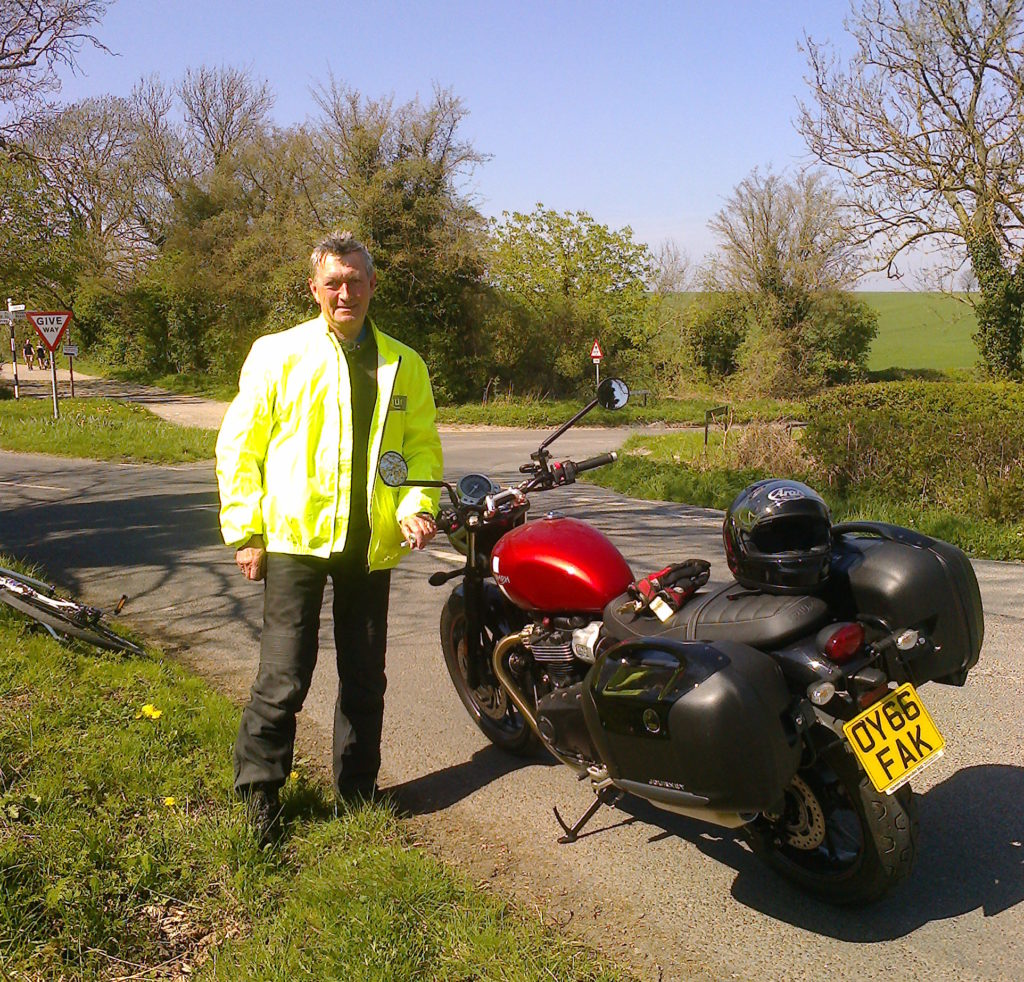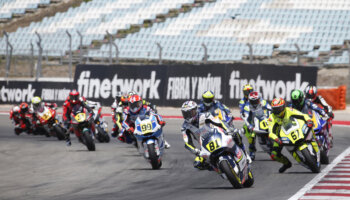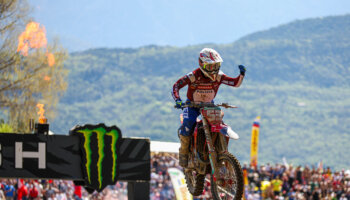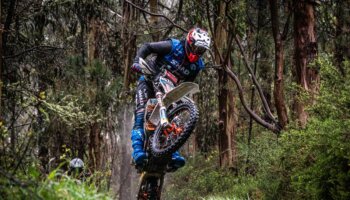FIM Europe Director of Public Affairs John Chatterton-Ross (in the photo above) explains what is new for riders.
We spoke a little about this in the interview published in February; can you give more detail on this subject and explain what all this news about “PPE” means?
“Yes. PPE – Personal Protective Equipment. It means protective equipment that we wear or use to keep us safe from injury. Human Protective Equipment might have been a better name…
“For a motorcyclist the most obvious item is the helmet but here we are concerned with clothing. I will deal with the legal aspects at the end as that does not interest everyone”.
Can you give the position of FIM Europe and what advice would you give riders?
“I think it is always a good idea to reflect on the racing experience. The first riders to go really fast in the early 1900s were Americans racing on banked board tracks. – They could get up to over 160kph which was impressive for the time!”
What equipment did they use?
“The photographs of the time show – naturally – the earliest helmets, strong boots and leather trousers. What they did not wear in the early days was a leather jacket. They worked out where the main risk of abrasion injury was – andz< it is not the upper body. This is counter intuitive as most street riders will make their focus the jacket”.
So what do you advise?
“The journey to and from work: This depends on where in Europe you live. I spent thirty nine years travelling by motorcycle to and from school and later to work. I live in the UK and it rains a lot. So as well as helmet, jacket and gloves I always wore boots too and took my work shoes in a box on the back of the bike. Later, when I was serving as a police officer I did not need to do that as the police boots worked fine on the motorcycle too.
“As it rains so much I always put on strong motorcycling over-trousers which give a limited amount of protection if you do have a fall. In summer this could sometimes be a little uncomfortable but it was worth that for the protection”.
Here in Rome the weather is different!
“Yes, exactly. It all depends where you are as motorcycling needs are so different. The good news is that today we have that fabulous Australian invention – motorcycling jeans! Actually it is more than that as some companies make protective trousers in other styles. These include chinos, cargo style with side pockets, military style trousers. – There is quite a range”.

Can you explain more about these products? Are they all much the same?
“No. At the lower end there are designs that have protective fabric in the seat area, the hips, and the knees. This will give about 50% coverage to the lower body in the most critical areas.
“Next there are some designs with a little more coverage about 60%. Finally there are designs with full coverage inside the garment and often with knee protectors and hip protectors as well to reduce the risk of impact injury in a fall.
“The disadvantage is that they are much warmer and about half a kilo in weight above the lighter designs. The advantage is that they can be made to the full CEN specification for professional riders”.
Can you explain what that is?
“Yes. CEN is the European Committee for Standardisation. There are CEN standards for a huge range of things we use every day. Anything that has a “CE” mark on it. Although the standard was originally devised with professional riders in mind some companies make products to that level and sell them to everyone who wants them”.
Are there things to look out for when shopping?
“Yes. This is where things become complicated. Those jeans with the 50% or 60% coverage cannot meet the standard. – This does not make them, “bad products.” The reputable brands do testing using the abrasion part of the tests in the professional standard.
“You must read the label very carefully and if you are not sure read the company internet site first! Do not rely only on the sales staff in the motorcycle shop.
“A good guide – if you are after the basic product – is to choose one from a brand that also makes motorcycling jeans that meet the CEN standard. If they know how to do this you can be sure they know how to make the basic product really well too. They will be paying attention to the stitching and the quality of the fabric for all of their range”.
Are there any other pitfalls?
“Yes, I am sorry to say there are. Moving away from jeans the other most popular form of clothing is the motorcycle suit which is designed to protect riders from bad weather and also to give some protection in a fall.
“The vast majority of these – from all brands – only have CE marked protectors! The garment as a whole unit is generally NOT tested”.
Will this change?
“Yes. This is the key point about the new European law coming next year. The authorities have decided that a jacket, suit or trousers sold with protectors fitted (or just the pockets to add them in as a separate accessory) is PPE. This means the whole garment has to be tested”.
Will it still be possible to buy water and wind proof over suit or jacket and trousers?
“Yes, this will still be allowed so long as it does not have pockets to fit protectors and is just a weather proof garment to wear over other clothes. A rain jacket for wearing over other clothing – this will be legal to sell under the new law”.
Will the new EU law force riders to wear protective clothing?
“No! This is not part of European Union law. If you don’t want to wear protective clothing you don’t have to”.
Are there any countries in Europe that have laws about wearing PPE?
“All countries in the EU have a national helmet wearing law. Belgium has made it illegal to ride around in tee shirt and shorts. – When riding you must have your arms and legs covered but that could be by any type of clothing. The Belgian authorities admits that this is really just a gesture, but they say they think it has encouraged more riders (now they have to cover up) to go and buy some real motorcycling clothing. France is bringing in a law on wearing gloves whilst riding too”.
Is it true that France has different laws about what clothing can be sold?
“Yes. France has taken a lead here with a decision some time ago to interpret the current 1989 law differently. They established a testing protocol that uses some aspects of the existing CEN professional standard. – So there is some clothing that you can buy in the rest of Europe that you won’t find any more in French shops”.
How do you think this will work out and what products will be available in the future?
“It is not easy. On the one hand you have the safety aspect and companies cannot be expected to design products for other uses….it is motorcycling clothing. The difficulty is the customer sees things from another perspective.
“We cannot all be the CEO and have a private suite to change clothes when we get to work! If you are working in a formal environment you cannot turn up for work in jeans. So the solution has to be a pair of jeans for riding – probably the 50% or 60% coverage ones that you can fold up and put somewhere in the office near your desk.
“To explain the point let’s take the example of the fire fighter. I got to know many of these brave men and women when I was serving in the police. For a building fire you need the absolute maximum of protection. – Otherwise you will die within seconds. It means breathing apparatus, a heavy suit to protect against flames, footwear that will protect if you step on a live electric cable, and finally the clothing will need to protect against cuts.
“After that the next job is one which is much more common today when it comes to fires – a forest fire. That heavy suit could be a killer in that situation. You need a lighter one so that you can run from danger if the wind direction suddenly turns.
“The next job is the one that sadly is a major part of being a fire fighter today. – Attending road traffic collisions to cut people free from vehicles. Often at those events you will see the firefighters discard their jackets.
“It is not as dramatic with motorcycling but in a city journey you don’t want to be so hot you lose concentration”.
Is there a solution on offer?
“CEN is working on a new set of standards for motorcycling clothing. This will have more levels so that those lighter weight part coverage denims (and chinos and cargo pants) can be certificated for abrasion protection. I think it would be a total disaster if these new innovative products were removed from the market at the very point where more people are buying them.
“FIM Europe welcomes this practical approach. There is of course still a need for higher level clothing with the addition of protectors for the back, elbows, knees and hips as well as abrasion protection. The key is getting the balance right”.
Some reports suggest that there may be problems with “motorcycle style” leisure clothing?
“Yes. I have heard this too. Motorcycling has had such an impact on our culture that there are fashion designs that reference it. There are still some people who want to dress like Marlon Brando. – The institutions of the European Union may be powerful – but even they cannot stop this!
“To be serious – often these fashion garments are made from soft sheep leather and they would be of no use if you fell from your motorcycle. Moving on from Marlon there is the Steve McQueen look. I have a fashion jacket that is styled to look like the clothing he wore when competing in the ISDT trials in the 1960s. It is not made of waxed cotton and it is not a real motorcycling jacket. I would never wear it when riding.
“Finally there is the leisure clothing sold in motorcycling outlets. Many companies like to sell branded clothing. This might be ordinary (not motorcycling) jeans, tee shirts etc. I think any motorcycling dealer in the future would be wise to display this on a separate rack from the motorcycling clothing. If a customer wants to buy a pair of regular jeans – that is up to them. If they wear them when riding that is their choice”.
I guess you have a wardrobe full of motorcycling clothing, how do you choose what to wear?
“If I am just going to the town I do the same as when I was riding to work every day. I focus just on the basics and I am happy to ride in a pair of light motorcycling jeans, boots – I still have my old police ones (!) Often a lighter weight jacket and of course helmet and gloves.
“If any journey is going to include riding on main roads out of town – or the motorway- I will always use leather trousers or full protection motorcycling jeans. Also a heavier jacket with a back protector fitted or a leather jacket. I use the bright rain jacket in the photograph as well even if it is not raining, or another one I have which is orange colour”.
You focus a lot on protection from abrasion injury, why is that?
“This is the most important thing that clothing can help with. The skin is an organ of the body and an ordinary pair of jeans – even the highest quality ones – will last about a second before your skin is exposed to the road surface. These injuries are very difficult (and painful!) to treat. There is also the risk of infection as the road surface is full of dirt and oil.
“Impact protection is good to have too but abrasion protection is the most important thing of all.
“I have focussed here on clothing but you can also buy new designs of motorcycling footwear. Everything from US style sneakers to some really smart leather boots with side zips as well as laces that you can wear all day. – Some will even work with formal office clothing too”.
Is FIM Europe engaged with developing the new standards?
“Yes, we have returned to this work as an organisation with observer status in CEN. We were involved in past years when the current professional standard was developed. Unfortunately that never really took off with the general market which is a matter of regret.
“Things began to change when the Australians realised that for their top level jeans with full coverage inside and protectors they could achieve level one. Now some of these products also achieve the higher level two. The last CEN meetings were hosted by FIM in Switzerland and we meet again soon in early June at the Harley Davidson offices for Europe and the Middle East which are in Oxford in the UK”.
You will attend?
“Yes, I will be riding my motorcycle to the meetings!”























